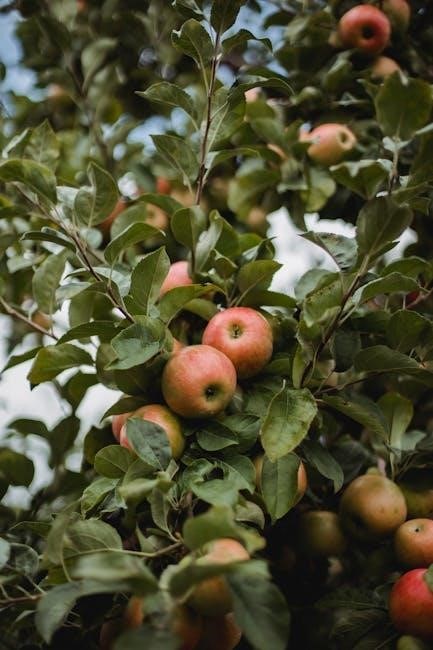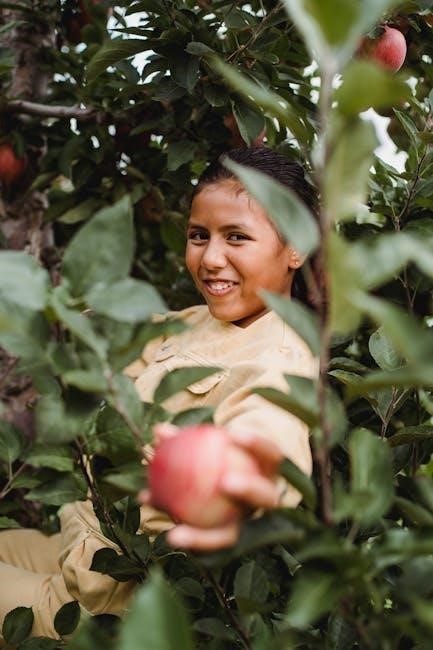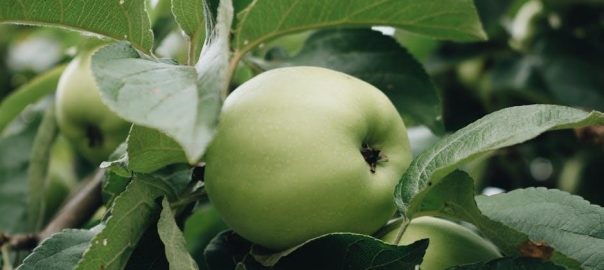Welcome to our comprehensive guide on identifying apple trees! Discover how to recognize these beloved trees by examining their leaves‚ bark‚ flowers‚ and fruit. Learn about essential tools and resources‚ from mobile apps to field guides‚ that will aid in accurate identification. This guide covers seasonal changes‚ key characteristics‚ and expert tips to help you confidently identify apple trees in any setting.
Importance of Identifying Apple Trees
Identifying apple trees is crucial for gardeners‚ farmers‚ and nature enthusiasts. Accurate identification ensures proper cultivation‚ pest management‚ and fruit production. It helps distinguish between edible and ornamental varieties‚ preventing unintended uses. Knowing the species also aids in understanding growth habits‚ soil preferences‚ and climate tolerance. Additionally‚ identification supports biodiversity conservation and ecological balance. Whether for harvesting or landscaping‚ recognizing apple trees accurately enhances productivity and appreciation of these versatile plants.
Key Characteristics for Successful Identification
Successful apple tree identification relies on observing distinct features. Leaves are typically oval-shaped with serrated edges‚ often bright green and hairy underneath. Bark is smooth and gray when young‚ becoming flaky and mottled with age. Flowers bloom in spring‚ white or pink‚ arranged in clusters. Fruit varies in size‚ color‚ and texture‚ from sweet dessert apples to tart cooking varieties. Recognizing these traits‚ along with seasonal changes and growth habits‚ ensures accurate identification of apple trees in various environments and stages of development.
Tools and Resources for Identification
Identifying apple trees is made easier with the right tools and resources. Mobile apps like Leafsnap and PlantSnap offer instant recognition by scanning leaves and flowers. Field guides provide detailed descriptions of tree characteristics‚ while online databases‚ such as those from botanical gardens‚ offer extensive image libraries. Consulting local nurseries or experts can also clarify uncertainties. Additionally‚ seasonal observations and comparing tree features with known varieties enhance accuracy. These tools collectively empower anyone to confidently identify apple trees in gardens‚ orchards‚ or wild settings.
Identifying Apple Trees by Leaves
Apple tree leaves are oval-shaped with pointed tips and serrated edges. They are bright green on the upper side and lighter green underneath‚ providing clear identification clues.
Leaf Shape and Structure
Apple tree leaves are typically oval-shaped with pointed tips and serrated edges. They range in length from 2 to 4 inches‚ with a smooth‚ glossy texture on the upper side and a lighter‚ often downy underside. The veins are prominent‚ running from the petiole to the tip‚ creating a distinctive leaf structure. These characteristics‚ combined with their bright green color‚ make apple leaves easily identifiable. Variations in shape and texture can occur among different apple varieties‚ but the overall structure remains consistent‚ aiding in accurate identification.
Leaf Color and Texture
Apple leaves typically display a dark green‚ glossy upper surface and a lighter green‚ often downy underside. The texture is smooth to the touch on the upper side‚ while the lower side may feel slightly fuzzy due to fine hairs. During the growing season‚ the leaves remain vibrant‚ turning yellow‚ orange‚ or red in the fall. This color variation and texture provide key clues for identifying apple trees‚ as these traits are consistent across most varieties‚ though specific types may exhibit slight differences in shade and feel.
Leaf Arrangement on the Branch
Apple tree leaves are arranged alternately on the branch‚ meaning they grow singly from the stem at irregular intervals. Each leaf is attached by a short petiole‚ often accompanied by small stipules at the base. This alternate pattern is a key identifier‚ as it differs from opposite or whorled arrangements seen in other species. The leaves themselves are simple‚ not compound‚ and their placement allows for maximum sunlight exposure. This arrangement‚ combined with the petiole and stipule characteristics‚ aids in distinguishing apple trees from similar species‚ making it a valuable trait for accurate identification.

Identifying Apple Trees by Bark
Apple tree bark is typically gray‚ smooth in youth‚ and develops scaly ridges with age. Lenticels‚ small raised pores‚ are visible on the surface‚ aiding identification.
Bark Texture and Patterns
Apple tree bark is initially smooth and gray‚ becoming scaly and rugged with age. It features small‚ raised lenticels and develops a mottled appearance with patches of gray‚ brown‚ and tan. The texture varies from tight and smooth in young trees to loose and fissured in older ones. These patterns help distinguish apple trees from similar species. Observing the bark’s texture and coloration provides valuable clues for identification‚ especially during winter when leaves are absent.
Bark Color and Mottling
Apple tree bark exhibits a range of colors‚ from smooth gray in youth to mottled shades of gray‚ brown‚ and tan as it matures. The mottling creates a distinctive patchwork appearance‚ with darker furrows separating lighter areas. This color variation is more pronounced in older trees and helps distinguish apple trees from other species. The bark’s coloration and mottling patterns are key identifiers‚ especially during winter when foliage is absent. These visual cues provide valuable insights for accurate tree identification and appreciation of their natural beauty.
Seasonal Changes in Bark Appearance
Apple tree bark transforms with the seasons‚ offering distinct identification cues. In spring‚ new growth may expose smoother‚ lighter patches. Summer bark remains relatively consistent‚ with mottling becoming more apparent. Fall brings slight darkening of colors‚ while winter highlights the intricate patterns and textures as foliage fades. These seasonal shifts in bark appearance provide valuable clues for identifying apple trees throughout the year‚ making observation a dynamic and rewarding process for enthusiasts and experts alike.

Identifying Apple Trees by Flowers
Apple tree flowers are a key identification feature‚ typically blooming in spring with white or pink petals. Their arrangement‚ color‚ and fragrance provide distinct clues for recognition.
Flower Color and Bloom Time
Apple tree flowers typically bloom in spring‚ displaying clusters of white or pink blossoms. The flowers are fragrant and attractive to pollinators‚ with their color varying slightly by variety. Bloom time ranges from early to late spring‚ depending on climate and specific cultivar; Timing is critical for pollination‚ often occurring between March and May in many regions. These vibrant blooms are not only beautiful but also essential for fruit development‚ making them a key feature for identification and understanding the tree’s life cycle.
Flower Arrangement and Structure
Apple blossoms are arranged in clusters‚ typically containing 4 to 6 flowers per cluster. These flowers grow in a corymb-like raceme structure‚ creating a stunning display. Each blossom is small‚ with five petals that form a delicate‚ star-shaped appearance. The flowers also feature numerous stamens and a central pistil‚ surrounded by green sepals that form a star-shaped base. This arrangement not only enhances the tree’s beauty but also aids in cross-pollination‚ making it a key feature for identification and understanding the tree’s reproductive cycle.
Flower Fragrance and Attractiveness to Pollinators
Apple blossoms emit a delicate‚ mild fragrance that attracts pollinators like bees and butterflies. The scent‚ while not overpowering‚ is crucial for drawing these essential visitors. The clusters of white or pink flowers create a visually appealing display‚ further enticing pollinators. This natural attraction plays a vital role in the tree’s reproductive cycle‚ ensuring proper pollination and fruit development. The combination of fragrance and vibrant color makes apple blossoms highly effective at attracting beneficial insects‚ supporting both the tree’s growth and local ecosystems.

Identifying Apple Trees by Fruit
Apple tree identification by fruit involves examining size‚ shape‚ color‚ and taste. Varieties like Honeycrisp and Granny Smith differ in texture and ripening times‚ aiding accurate classification.
Fruit Size and Shape
Apple fruit size and shape are key identification features. Varieties range from small crab apples to large dessert apples. Shapes vary from round to oval or elongated. Red Delicious apples are notably elongated‚ while Fuji apples are round and symmetrical. Size and shape differences help distinguish between cultivars‚ with some varieties exhibiting prominent ribbing or unusual forms. These characteristics‚ combined with color and texture‚ provide essential clues for accurately identifying apple tree varieties and understanding their unique traits.
Fruit Color and Skin Texture
Apple fruit color and skin texture are vital for identification. Apples display a wide range of colors‚ including red‚ green‚ yellow‚ and bi-colored or tri-colored patterns. Some varieties‚ like Red Delicious‚ feature deep red skin‚ while others‚ such as Granny Smith‚ have green skin. Skin texture varies too‚ with some apples having smooth‚ glossy surfaces and others exhibiting russet or ribbed textures. For example‚ Honeycrisp apples often show yellow skin with red stripes and a textured surface. These traits‚ combined with size and shape‚ help distinguish between apple varieties and enhance identification accuracy.
Fruit Taste and Ripening Time
Apple fruits vary significantly in taste‚ ranging from sweet and juicy to tart and crisp. Honeycrisp apples are known for their exceptional sweetness and crunchy texture‚ while Granny Smith apples offer a sharp‚ tangy flavor. Ripening times also differ‚ with some varieties like Fuji and Gala maturing in late summer‚ and others like Braeburn ripening in early fall. Understanding the taste profile and ripening schedule of apple fruits is essential for accurate identification and determining the optimal harvest time for each variety.
Seasonal Changes in Apple Trees
Apple trees transform with the seasons‚ showcasing new growth in spring‚ vibrant foliage in summer‚ colorful harvests in fall‚ and dormancy in winter‚ each phase offering unique identification clues.
Spring: Blossoms and New Growth
In spring‚ apple trees burst into life with vibrant blossoms‚ typically pink or white‚ that signal the start of the growing season. These flowers are arranged in clusters and emit a delicate fragrance‚ attracting pollinators like bees. Simultaneously‚ new leaves emerge‚ often appearing reddish before maturing into their summer green color. The branches become adorned with tender shoots‚ creating a lush canopy. This season offers a prime opportunity to observe the tree’s flower structure‚ a critical feature for identification‚ as different varieties display distinct bloom times and colors‚ aiding enthusiasts in distinguishing one type from another. Additionally‚ the bark’s condition and any new growth patterns can provide further clues‚ making spring a key period for detailed observation and study of apple tree characteristics.
Summer: Leaf and Fruit Development
During summer‚ apple trees reach their full foliage‚ with leaves maturing into a deep green color and a smooth‚ glossy texture. The leaves are ovate‚ serrated‚ and grow alternately on branches. This season marks theactive development of fruit‚ as blossoms transition into apples. The fruit enlarges‚ and its skin begins to display characteristic colors‚ ranging from green to red‚ depending on the variety. The apples’ skin texture and thickness also become more pronounced‚ offering clues for identification. Additionally‚ the tree’s structure and leaf arrangement provide insight into its health and specific variety‚ making summer an ideal time for detailed observation and documentation of growth patterns. The presence of lenticels on the fruit’s surface and the tree’s overall vigor further aid in distinguishing between different apple tree types‚ as each variety may exhibit unique traits during this stage. By carefully examining these features‚ enthusiasts can gain a deeper understanding of the tree’s identity and developmental cycle‚ ultimately enhancing their ability to accurately identify apple trees in various settings.
Fall: Harvest and Foliage Changes
In the fall‚ apple trees showcase vibrant foliage changes‚ with leaves turning shades of yellow‚ orange‚ and red before dropping. This season signals the harvest period‚ as apples reach maturity and are ready for picking. The fruit’s color‚ texture‚ and sweetness become fully pronounced‚ making it an ideal time for identification based on variety-specific traits. Additionally‚ the tree’s structure becomes more visible as foliage thins‚ revealing branching patterns and bark details. Observing these autumnal transformations provides valuable insights into the tree’s identity and health‚ aiding accurate identification and ensuring a successful harvest.
Winter: Dormancy and Bark Features
During winter‚ apple trees enter dormancy‚ shedding their leaves and revealing distinct bark patterns. The bark’s texture‚ color‚ and mottling become prominent identification features. Gray‚ smooth‚ or flaky bark with horizontal lenticels (breathing pores) is characteristic. Winter highlights the tree’s structure‚ making it easier to observe branching patterns and trunk thickness. Dormant buds‚ small and rounded‚ are another clue‚ while the absence of foliage allows for a clearer view of the tree’s framework. These visible features aid in identifying apple tree varieties even in the cold months when other elements are less apparent.
Using Technology for Apple Tree Identification
Utilize mobile apps‚ online databases‚ and expert consultations to enhance your apple tree identification process. Technology provides instant access to detailed guides‚ images‚ and professional insights‚ ensuring accuracy and efficiency in recognizing tree species.
Mobile Apps for Tree Identification
Popular mobile apps like iNaturalist‚ Leafsnap‚ and PlantSnap offer robust tools for identifying apple trees. These apps allow users to upload photos of leaves‚ bark‚ flowers‚ and fruit for instant recognition. Advanced algorithms and extensive databases ensure accurate results. Many apps also provide detailed descriptions‚ habitat information‚ and comparison features to distinguish between similar species. Additionally‚ social platforms within these apps enable users to share observations and learn from experts. Downloading these apps can significantly enhance your ability to identify apple trees efficiently‚ whether in your yard or while exploring nature.
Online Databases and Field Guides
Online databases and field guides are invaluable for apple tree identification. Websites like the USDA’s PLANTS database and university extensions provide detailed profiles of apple tree species. Field guides‚ such as the National Audubon Society Field Guide to Trees‚ offer high-quality images and descriptions of leaves‚ bark‚ flowers‚ and fruit. These resources often include interactive identification keys and maps showing species distributions. Experts curate this information‚ ensuring accuracy. Cross-referencing multiple sources enhances reliability‚ making online databases and field guides essential tools for precise apple tree identification.
Consulting Experts and Local Nurseries
Consulting experts and local nurseries is a highly effective way to identify apple trees. Horticultural experts‚ botanists‚ and experienced gardeners can provide precise insights based on their knowledge. Local nurseries often have extensive experience with regional apple tree varieties and can offer tailored advice. They can help identify trees by examining leaves‚ bark‚ flowers‚ or fruit samples; Additionally‚ experts can clarify confusing characteristics and suggest resources for further learning. This personalized approach ensures accurate identification and fosters a deeper understanding of apple tree biology and care.

Common Apple Tree Varieties
Explore the diverse world of apple tree varieties‚ from popular types like Honeycrisp and Granny Smith to heirloom and regional species. Discover their unique features‚ growth habits‚ and uses in cooking or as dessert apples‚ aiding in accurate identification and appreciation of their distinct characteristics.
Popular Varieties and Their Features
Discover the standout characteristics of popular apple varieties like Honeycrisp‚ known for its juicy‚ sweet flavor and crisp texture‚ and Granny Smith‚ famous for its green skin and tart taste. Red Delicious apples are recognized by their deep red color and elongated shape‚ while Fuji apples offer a sweet‚ well-balanced flavor. Golden Delicious apples are versatile‚ with thin skin and a mild taste‚ making them ideal for cooking and fresh eating. Each variety boasts unique features‚ from skin color to flavor profiles‚ aiding in identification and culinary uses.
Dessert vs. Cooking Apples
Dessert apples‚ like Honeycrisp and Fuji‚ are sweet and crisp‚ perfect for fresh eating. Their thin skin and juicy flesh make them ideal for snacking. In contrast‚ cooking apples‚ such as Granny Smith‚ are tart and firm‚ holding their shape when cooked. These apples are best for baked goods‚ pies‚ and sauces due to their high acidity and robust texture. Understanding the differences helps in selecting the right variety for culinary uses‚ ensuring the best flavor and performance in both sweet and savory dishes.
Challenges in Apple Tree Identification
Identifying apple trees can be tricky due to similar species‚ seasonal changes‚ and environmental influences. Accurate observation of leaves‚ bark‚ flowers‚ and fruit is essential for correct identification.
Mistakes to Avoid in Identification
When identifying apple trees‚ common mistakes include relying solely on fruit appearance‚ misjudging seasonal variations‚ and overlooking key characteristics like leaf serrations or bark texture. Avoid confusing apple trees with similar species‚ such as crabapples or hawthorns‚ by carefully examining multiple features. Overlooking growth habits or habitat preferences can also lead to errors. Ensure accurate identification by considering the tree’s overall structure and using a combination of traits rather than focusing on a single characteristic.
Similar Species and Lookalikes
Apple trees can be confused with species like crabapples‚ hawthorns‚ and mountain ash due to similarities in fruit and foliage. Crabapples often have smaller‚ tart fruits and more vibrant fall colors‚ while hawthorns are distinguished by their thorny branches and berry-like fruits. Mountain ash‚ though unrelated‚ shares a similar fruit appearance but lacks the characteristic apple tree bark. Carefully examine leaf serrations‚ bark texture‚ and fruit size to avoid misidentification. These lookalikes often grow in similar habitats‚ making accurate identification crucial for correct classification.

Apple Tree Identification by Growth Habits
Apple trees vary in size and shape‚ from dwarf varieties to large standard trees. They often display rounded or oval crowns with wide‚ spreading branches. Growth rates differ‚ with some cultivars exhibiting slow‚ moderate‚ or vigorous growth patterns. Branching structures can be open or dense‚ influencing light penetration and fruit production. Observing these growth habits helps distinguish apple trees from other species and aids in identifying specific cultivars.
Tree Size and Crown Shape
Apple trees vary in size‚ typically growing between 15 to 30 feet tall‚ with dwarf varieties reaching around 6 to 10 feet. Their crowns are often rounded or oval‚ with wide‚ spreading branches that create a broad canopy. Standard trees develop a central leader‚ while dwarf varieties may have a more compact‚ bushy shape. The size and crown shape are influenced by rootstock and cultivar‚ making these features useful for distinguishing between different apple tree varieties and aiding in accurate identification.
Growth Rate and Branching Patterns
Apple trees typically exhibit a moderate growth rate‚ averaging 1 to 2 feet per year. Dwarf varieties tend to grow slower‚ while standard trees grow taller over time. Branching patterns are usually wide and spreading‚ with a central leader in standard trees; This structure supports the tree’s ability to bear fruit efficiently. Understanding growth rates and branching patterns helps in distinguishing between dwarf and standard varieties‚ aiding in accurate identification and management of apple trees in various settings.
Apple Tree Identification by Habitat
Apple trees thrive in natural and cultivated habitats‚ preferring well-drained soil and temperate climates. They adapt to various environments‚ making them suitable for diverse growing conditions and regions.
Natural vs. Cultivated Environments
Apple trees are found in both natural and cultivated settings. In the wild‚ they often grow in woodlands or along streams‚ preferring well-drained soil and full sun. Cultivated varieties are typically planted in orchards‚ benefiting from careful pruning and pest management. These environments influence growth patterns‚ with wild trees sometimes appearing more rugged and cultivated trees displaying more uniform shapes and fruit production. Understanding their habitat helps in accurate identification and appreciation of their adaptability.
Climate and Soil Preferences
Apple trees thrive in temperate climates with cool winters and warm summers. They prefer well-drained soil with a pH between 6.0 and 6.5. In natural habitats‚ they often grow in woodlands or along streams‚ while cultivated varieties are typically planted in orchards with fertile‚ loamy soils. Regional climates influence fruit quality‚ with cooler areas producing better flavor. Understanding soil and climate preferences aids in identifying apple trees and selecting suitable varieties for specific environments. This knowledge is crucial for both identification and successful cultivation.
Identifying apple trees is a rewarding journey‚ exploring their leaves‚ bark‚ flowers‚ and fruit. With the right tools and seasonal insights‚ you’ll confidently recognize these iconic trees‚ enhancing your appreciation for nature’s beauty and bounty.
Apple trees are identified by their broad‚ rounded leaves with serrated edges‚ smooth gray bark‚ and clusters of white or pink flowers. The fruit varies in size‚ color‚ and texture‚ from bright red to green. Seasonal changes reveal distinct traits‚ like spring blossoms and fall foliage. Growth habits‚ such as tree size and branching patterns‚ also aid identification. Tools like mobile apps and field guides enhance accuracy. By observing these features‚ you can confidently recognize apple trees in various environments and stages of growth.
Final Tips for Accurate Identification
For precise apple tree identification‚ consult multiple sources to cross-verify traits. Note seasonal variations in leaves‚ bark‚ and fruit. Observe the tree’s overall structure and growth habits. Document findings with photos and descriptions for later reference. Engage experts or local nurseries for confirmation. Avoid common mistakes like confusing similar species. Patience and thorough observation ensure accurate results‚ making your identification journey both rewarding and educational.
Additional Resources
Explore recommended books‚ online communities‚ and specialized forums for further insights and expert advice on apple tree identification and care.
Recommended Books and Guides
For in-depth knowledge‚ explore books like “The Apple Tree Guide” and “Botanical Identification of Fruit Trees.” These resources offer detailed descriptions and images to aid in identifying apple tree varieties. Regional guides‚ such as those focusing on specific climates or zones‚ provide tailored insights. Additionally‚ online databases and community forums dedicated to botany and horticulture can supplement your learning. These tools are invaluable for enthusiasts and professionals alike‚ ensuring accurate and comprehensive identification of apple trees.
Online Communities and Forums
Engage with online communities like Reddit’s r/TreeIdentification or r/Gardening for real-time advice on apple tree identification. Forums such as GardenWeb and Horticulture Talk offer valuable insights from experts and enthusiasts. These platforms allow you to share photos and descriptions of your tree for accurate identification. Additionally‚ specialized Facebook groups and botany-focused Discord servers provide interactive learning opportunities. Online communities are excellent resources for resolving identification challenges and connecting with like-minded individuals passionate about apple trees.
